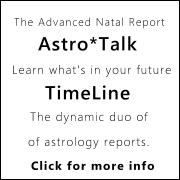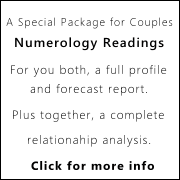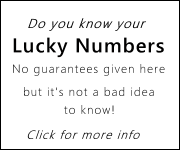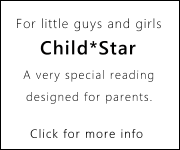Astrology Index | Numerology Index
Help with the Chart
- Figuring houses & signs on the cusps
- Finding what sign each planet is in
- Figuring house each planet is in
- Finding the aspects between planets
- Explanation of letters "C" "F" "M" on the table
- Explanation of letters "E" "F" "A" "W" on the table
- Explanation of "Asc" "MC" "IC"
-
Planets in Signs
- The symbols representing the planets are positioned around the inner ring of the Astrodienst chart. netNumerology.com delineates the Sun, the Moon, Mercury, Venus, Mars, Jupiter and Saturn by sign placement. On the left-hand margin of the Astrodienst chart page, under the birth data listing, there is a box showing the position of the Sun, the Moon, and the planets. Shown is the symbol for the planet, the name of the planet, and then the position in the zodiac. The position is shown by degree (0-29), next the sign of the zodiac abbreviated to 3 letters, and finally the minute and seconds of the degree. Sun 20 Can 45'10" would be that the Sun was at 20 degrees, 45'10" of the sign Cancer at the moment of birth. Refer to Planets in Signs to obtain your reading for each placement.
-
The Houses of the Horoscope
- The standard chart from Astrodienst shows the wheel with the twelve houses of the chart on the outside ring. The circle is divided in four parts by a vertical and a horizon line. These divisions are on the Angles (see http://netNumerology.com/angles.html). On the left side or in astrology lingo, the "east" side of the chart, the horizontal line marks the beginning of the first house. This is called the Ascendant. The symbol there is called the Rising Sign because it was the sign on the horizon or rising above the horizon when you were born. This "east " point cusp of the 1st house is normally marked "AC." Traveling counter-clockwise from this point are the sequential houses of the horoscope. Just beneath the box showing the planets and their position there is a small rectangular box showing the zodiac position of the AC (or 1st house), and houses 2, 3, MC (or 10th house), 11, and 12. These are the houses starting at the top of the chart (the MC/10th house), and proceeding around the left side of the circle. Given these, it is then up to you to place in the other 6 house cusps making them the precise opposite of the first 6. Those opposite signs are Aries/Libra, Taurus/Scorpio, Gemini/Sagittarius, Cancer/Capricorn, Leo/Aquarius, and Virgo/Pisces. So if you have Gemini on the AC/1st house, you will have Sagittarius on the DC/7th house. The readings for each of the signs on each of the house cusps begins at http://netNumerology.com/housecusps.html.
-
Planets in Houses
- Here is another area where things can get a little confusing. The symbols within the inner ring of the chart show where the planets are. The chart shows the symbol for the planet, and two numbers; one larger, the other smaller. The larger number is the degree and the smaller is the minutes, both referring to the zodiac sign shown on the outside ring where the planet is located. Refer to planets-in-houses to get the mini-reading for each planet.
-
Planets in Aspect
- This is perhaps the most difficult area for the beginner since the chart information on aspects is all in symbols. netNumerology.com only discusses the major aspects formed by the Sun, the Moon, Mercury, Venus, and Mars. The symbol representing the Sun is in the first column, first row. The symbol representing the Moon is in the second column, second row. Mercury is on the 3rd column, 3rd row, and so on. The aspects that are formed by the Sun, the Moon, Mercury, Venus, and Mars are shown by aspect symbol where the two planets intersect.
-
- There are several minor aspects that this site does not use. They are:
-
- Semi-sextile, angular value: 30°, effect: mildly easy
- Semi-square, angular value: 45°, effect: conflict, hard
- Quintile, angular value: 72°, effect: neutral
- sesquiquadrate, angular value: 135°, effect: conflict, hard
- Bi-quintile, angular value: 144°, effect: neutral
- Quincunx (Inconjunct), angular value: 150°, effect: mildly difficult
Here are the aspect symbols that you will be looking for
The Conjunction 
- The conjunction is formed when two planets are at approximately the same degree of the same sign. If this symbol appeared on the fourth row of the graph under the symbol for the Sun, it would mean that the Sun and Venus were in conjunction. If it appeared under the symbol of the Sun on the 10th row it would mean that the Sun and Pluto* were in conjunction. In a conjunction, the energies of the two planets are combined, and often the result is a strengthening of both.
The Sextile 
- Sextiles occur when two planets are approximately 60 degrees apart. This is the aspect of opportunity.
- The Square

- Squares occur when two planets are approximately 90 degrees apart. Square cause the friction and the hurdles that causes us to grow and become productive.
The Trine 
- A trine occurs when two planets are approximately 120 degrees apart. Trines bring about ease and comfort.
The opposition 
- The opposition occurs when two planets are about 180 degrees apart. As the name implies, opposition are obstacles that must be resolved.
-
- Start with the Sun, then the Moon, and in order Mercury, Venus and Mars. List all of the aspects that apply. Finally, look up the meanings of these aspects.
*Note that the symbol looking like a P & L combined is the old symbol for Pluto.
Still Need Help? Let me know if you have additional questions that I have not covered or more clarification on what is here. If your question would require me looking at your natal chart, be sure to include your birth information; date, exact time, place.
© Michael McClain 1996-2012. Permission is granted for unlimited noncommercial use. All other rights reserved.
|






|







